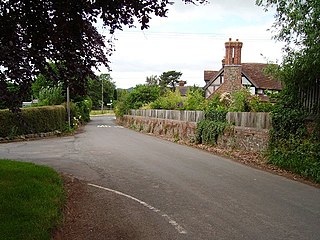
Atcham is a village, ecclesiastical parish and civil parish in Shropshire, England. It lies on the B4380, 5 miles south-east of Shrewsbury. The River Severn flows round the village. To the south is the village of Cross Houses and to the north-west the hamlet of Emstrey.

Meifod, formerly also written Meivod, is a small village, community and electoral ward seven miles (11 km) north-west of Welshpool in Montgomeryshire, Powys, Wales, on the A495 road and located in the valley of the River Vyrnwy. The River Banwy has a confluence with the Vyrnwy approximately two miles (3.2 km) to the west of the village. The village itself had a population of 317. The community includes the village of Bwlch-y-cibau and the hamlet of Allt-y-Main.

Minsterley is a village and civil parish in Shropshire, England. In the 2011 census, its population was 1,777. Minsterley lies one mile south-west of Pontesbury and 10 miles south-west of Shrewsbury. East from Minsterley along the A488, is the larger village of Pontesbury and to its south the hill range, the Stiperstones. The Rea Brook flows nearby and the smaller Minsterley Brook flows through the centre of the village.
High Ercall, also known in the past as Ercall Magna, is a village in the borough of Telford and Wrekin and ceremonial county of Shropshire, England. The civil parish is still called Ercall Magna, and had a total population of 1,679 at the 2001 census, reducing to 1,639 at the 2011 census. The parish includes the villages of Rowton, Ellerdine and Cold Hatton, and a number of hamlets including Cotwall, Osbaston, Poynton and Roden.

Leintwardine is a small to mid-size village and civil parish in north Herefordshire, England, close to the border with Shropshire.

Bitterley is a village and civil parish in Shropshire, England. According to the 2001 census the parish had a population of 802, increasing to 902 at the 2011 Census. The village is about 4 miles (6.4 km) east of Ludlow on the western slopes of Titterstone Clee Hill. Bitterley is the location for Bitterley Court about 0.62 miles (1.00 km) east of the modern village. Nearby to the east, is the small hamlet of Bedlam.

Peplow is a hamlet in Shropshire, England. It is part of the civil parish of Hodnet, a larger village to the north. The hamlets of Bowling Green and Radmoor are both in the village's vicinity.

Eyton on Severn is a small village in the English county of Shropshire, east of Shrewsbury. It is located on a ridge above the northern bank of the River Severn. The significant tributary of the Cound Brook joins the Severn at Eyton, albeit on the opposite bank. Wroxeter, the village located at a ruined Roman city, is only a mile north-west of the village. The hamlet of Dryton is just east of Eyton. All lie in the parish of Wroxeter and Uppington.

Cound is a village and civil parish on the west bank of the River Severn in Shropshire, England. It is 7 miles south east of Shrewsbury.

Beckjay is a hamlet in the south of the English county of Shropshire.

Upton is a civil parish north-east of Kislingbury and south-west of Dallington, in Northamptonshire, England about 3.5 miles (6 km) west of Northampton town centre along the A4500 road. Formerly a scattered hamlet, it is now part of the town. The area west of Northampton is now a major area of expansion of the town and named Upton after the parish.

Child's Ercall is a village and civil parish in Shropshire, England. It is located in a rural area between the towns of Market Drayton and Newport: the civil parish had a total population of 599 at the 2001 census, rising to 732 at the 2011 Census. The closest neighbouring village is Ollerton, around 1 mile to the west.

Moreton Corbet is a village and former civil parish, now in the parish of Moreton Corbet and Lee Brockhurst, in the Shropshire district, in the ceremonial county of Shropshire, England. The village's toponym refers to the Corbet family, the local landowners.

Ellerdine is a small hamlet located six miles north of the market town of Wellington, Shropshire.

Rowton is a small village in the Telford and Wrekin Borough, Shropshire, England. It is located seven miles north-west of Wellington. The area is a Chapelry Division of High Ercall Parish.

Goldstone is a small hamlet in eastern Shropshire, England, in the civil parish of Cheswardine. It lies in an isolated rural area north of Hinstock and Ellerton, around 5 miles (8 km) south of the nearest town, Market Drayton.

Isombridge is a small hamlet in rural Shropshire. It lies on the border of the civil parishes of Wrockwardine and Rodington, north of Wrockwardine village, near the River Tern. Population details are included under Rodington. Immediately to the north is another small hamlet, Marsh Green, which was formerly on the Shrewsbury Canal until the latter's closure.

The siege of High Ercall Hall in High Ercall, Shropshire, England took place during the First English Civil War. There were a total of three sieges. In each of the sieges, the Hall was held by the Royalists and besieged by the Parliamentarians. The final and longest siege took place from July 1645 to March 1646, when the Royalist commander surrendered the hall to the Parliamentarians.

High Ercall Hall or Ercall Hall is the remaining part of a larger complex in the village of High Ercall, Shropshire, 8 miles (13 km) north-east of Shrewsbury.

Broadward is a dispersed hamlet in south Shropshire, England, situated by the border with Herefordshire. It is in the civil parish of Clungunford, a village approximately 2 miles (3.2 km) to the north.



















